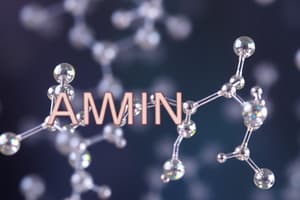Podcast
Questions and Answers
What does the dissociation constant of water (Kd) express?
What does the dissociation constant of water (Kd) express?
- The relationship between the pH of a solution and its temperature
- The relationship between the hydrogen ion concentration, the hydroxide ion concentration, and the concentration of water at equilibrium (correct)
- The strength of an acid in a solution
- The relationship between the hydrogen ion concentration and the hydroxide ion concentration
What is the condition in which the body fluids have excess base (alkali)?
What is the condition in which the body fluids have excess base (alkali)?
- Acidosis
- Homeostasis
- Alkalosis (correct)
- Neutralosis
What is the purpose of the Henderson-Hasselbalch equation?
What is the purpose of the Henderson-Hasselbalch equation?
- To estimate the pKa value of an acid
- To describe the behavior of weak acids and buffers (correct)
- To calculate the pH of a strong acid solution
- To determine the buffer capacity of a solution
What does a lower pKa value indicate about an acid?
What does a lower pKa value indicate about an acid?
What is the function of buffers in the body?
What is the function of buffers in the body?
What is the main characteristic of strong acids?
What is the main characteristic of strong acids?
What is the primary function of electrolytes in the body?
What is the primary function of electrolytes in the body?
What is the Henderson-Hasselbalch equation used to describe?
What is the Henderson-Hasselbalch equation used to describe?
What is the pH of a solution with a hydrogen ion concentration of 10^(-7) mol/l?
What is the pH of a solution with a hydrogen ion concentration of 10^(-7) mol/l?
What is the definition of an acid?
What is the definition of an acid?
At what pH does the maximum buffering capacity occur?
At what pH does the maximum buffering capacity occur?
What is the primary location of the bicarbonate-carbonic acid buffer system?
What is the primary location of the bicarbonate-carbonic acid buffer system?
What is the normal pH range of blood?
What is the normal pH range of blood?
What is the role of hemoglobin in the blood?
What is the role of hemoglobin in the blood?
What is the function of the phosphate buffer system in the body?
What is the function of the phosphate buffer system in the body?
Flashcards are hidden until you start studying
Study Notes
pH and Water
- Neutral pH of water is maintained by the dissociation constant of water (Kd), which expresses the relationship between hydrogen ion concentration, hydroxide ion concentration, and the concentration of water at equilibrium.
- pH is the negative log of the hydrogen ion concentration, expressed in mole per liter (mol/L).
Henderson-Hasselbalch Equation
- Describes the behavior of weak acids and buffers.
- Derives the pH as a measure of acidity in biological and chemical systems.
- Used for estimating the pH of a buffer solution and finding the equilibrium pH in acid-base reactions.
Acids and Bases
- Strong acids have a larger Ka value and dissociate completely in solution, whereas weak acids have a smaller Ka value and dissociate only partially.
- A lower pKa value indicates a stronger acid, which fully dissociates in water.
- Acidosis is a process causing increased acidity in the blood and other body tissues, while alkalosis is a condition where the body fluids have excess base (alkali).
Buffers
- Buffers, consisting of a weak acid and its conjugate base, resist changes in pH when hydrogen ions or hydroxide are added.
- Buffer capacity is the maximum amount of strong acid or strong base that can be added before a significant change in pH occurs.
Water and Thermal Regulation
- The structure of water allows it to resist temperature changes.
Electrolytes
- Electrolytes are minerals in the body that have an electric charge and help balance the amount of water in the body and maintain the body's acid-base level.
Strong and Weak Acids
- Inorganic acids like sulfuric acid and hydrochloric acid are strong acids that dissociate completely in solution.
- Organic acids, containing carboxylic acid groups, are weak acids that dissociate only partially in water.
Buffer Systems in the Body
- The major buffer systems in the body include the bicarbonate-carbonic acid buffer system, the hemoglobin buffer system, the phosphate buffer system, and the protein buffer system.
Metabolic Acids and Buffers
- Metabolic activity produces roughly 22,000 mEq of acids per day.
- The pH of blood is normally maintained between 7.36-7.44.
Bicarbonate Buffer System
- The bicarbonate buffer system operates principally in the extracellular fluid (ECF).
- The enzyme carbonic anhydrase is involved in the reaction.
Phosphate Buffer System
- The phosphate buffer system operates in the intracellular fluid (ICF).
- The reaction involves the conversion of H2PO4- to HPO42-.
Protein Buffer System
- The protein buffer system operates in cells and plasma.
Urinary Hydrogen, Ammonium, and Phosphate Ions
- Nonvolatile acids from metabolism cannot be excreted as expired CO2 and are excreted in the urine.
- The pH of urine is 5.5-7.0.
- Urinary ions include phosphate, ammonium, uric acid, dicarboxylic acid, citric acid, and sulfuric acid.
Studying That Suits You
Use AI to generate personalized quizzes and flashcards to suit your learning preferences.





